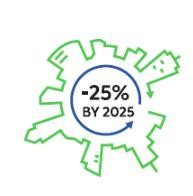Built environment: Connecting the dots of circularity
Serena Lisai, Project Officer, Built Environment Thematic Lead, ACR+
Why would a network of cities and regions promoting circular economy tackle the topic of the built environment? After years of focusing rather on the need for an energy transition for buildings, the discussion is moving to connecting the scarcity of our material resources and energy efficiency. Material resources play a strategic role in the building sector and of course in the overall development of cities and regions.
f we develop policies and recommendations mainly around energy efficiency, we risk underestimating the environmental impact of so-called sustainable buildings in terms of land use and material resources. Connecting these issues is the path chosen by the Association of Cities and Regions for Sustainable Resource Management (ACR+) to join the dots of circularity.
If we develop policies and recommendations mainly around energy efficiency, we risk underestimating the environmental impact of so-called sustainable buildings in terms of land use and material resources.
ACR+ has made the built environment one of its thematic priorities, together with sustainable food systems, circular lifestyles, policy and governance, and waste and material flows. The over 80 members of the network, mainly representing decentralised authorities, are engaged in discussions, learning opportunities, projects and events to acquire the right tools to include a circular approach in their local and regional initiatives.
ACR+ has already been advising and supporting its members on including the waste hierarchy within their local policies for 30 years. Today, it keeps pushing not only for even more challenging targets that can foster a circular transition and a sustainable material resource management but also for public authorities to fully seize their role and for all actors and fields to work together. This brings us back to the necessity to link material resources and energy when talking about built environment policies.
The most visible aspect of material resource management in the built environment is obviously construction and demolition waste (CDW). As is well described in the technical report recently published by the European Commission’s Joint Research Centre, CDW is responsible for more than one third of all waste generated in the EU.We need to prefer technologies supporting recycling and preparation for reuse rather than end of pipe solutions like landfill and incineration (in some cases) for most of the CDW fractions.
Cities can be seen as material stocks, and the promotion of renovation projects can boost a circular urban metabolism, reusing and valorising the exist ing resources.
The financial costs of these operations are likely to increase significantly, due to increased costs for processing and selective demolition, which represents the main barrier to this sector transitioning to circularity. Reuse and recycling of individual material fractions of CDW can bring significant societal and environmental benefits strongly reducing external costs.
Besides the mere management of CDW, the building sector requires a more comprehensive approach. It should support sustainable land use that reduces urban soil sealing, promoting a cultural change aimed at extending the life of existing buildings, and integrating energy efficiency with circular material resource management.
Considering that 53% of the existing European buildings’ stock was built before 1971, and only 6% after 2000, the appropriate balance between energy efficiency and material use should be analysed for each case. Renovation projects offer a great opportunity to implement a comprehensive approach, linking energy efficiency with circular material resource management, while avoiding urban sprawl and building too much on urban soil .
The recent Belgian Renovation Week organised by the three Belgian regions within the framework of the Belgian Presidency of the Council of the European Union drew attention to the role that policymakers can play in supporting renovation projects, based on local and efficient reuse of the materials, social housing, a multistakeholder and participatory approach, and the use of alternative bio-based products. Cities can be seen as material stocks, and the promotion of renovation projects can boost a circular urban metabolism, reusing and valorising the existing resources.

/ / image from acrplus
What can decentralised authorities do, then, to boost a circular approach to the built environment? In the first place, they have the legal power to give planning permission, through which they can impose some sustainability criteria.
Moreover, city governments can act as front runners and lead the transition by providing good examples. For example, green public procurement is a concrete tool in their hand that can serve to guide various stakeholders towards a fair and circular transition. Last not but least, they can support local players by setting up financing schemes to promote innovative sustainable solutions and products, and encourage the use of certification.
All in all, cities have great potential to foster the circular transition while boosting a green, fair and accessible built environment. Renovation policies and initiatives coupled with a clear balance between energy efficiency and sustainable material resource management can help to reach the no net land take targets and reduce urban soil sealing.
Some recent examples, such as the Flemish Region and its ZIN project, provide interesting insights into the role played by green public procurement and the implementation of a circular approach in the building sector. We are waiting for other cities to follow!
Serena Lisai, Project Officer, Built Environment Thematic Lead, ACR+